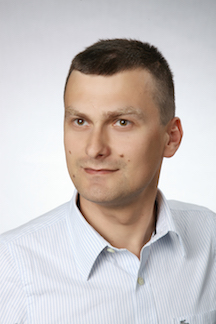 Pawel Skruch received the M.S. degree with honors in automation control from the Faculty of Electrical Engineering, Automatics, Computer Science and Electronics of the AGH University of Science and Technology in Krakow, Poland, in 2001 and the Ph.D. degree (summa cum laude) from the same university in 2005. He received his D.Sc. (Habilitation) degree in Automatics and Robotics from the AGH University in 2016. Since 2007 he has been Assistant Professor in Department of Automatics and Biomedical Engineering at the AGH University of Science and Technology in Krakow and a member of Dynamical Systems and Control Theory Team that is led by Prof. Wojciech Mitkowski. Since 2001 he has been also working at Delphi Technical Center Krakow in Electronics & Safety division where currently he is leading an R&D group for Active Safety, Advanced Driver Assistance and Automated Driving systems. In 2014, he together with Dr. Marek Dlugosz founded AGH University-Delphi laboratory for autonomous vehicle driving. Since 2014 he has been also one of the mentors of the student’s research circle INTEGRA. He is also co-founder of INCOSE Polish Chapter Foundation and a member of INCOSE organization. He is authored and co-authored of 2 monographs and more than 80 research papers (11 book chapters, 26 journals papers, 52 conference proceedings). He supervised 23 Master theses and 21 Bachelor theses. His current research is in the areas of dynamical systems, autonomous systems, modeling and simulation and applications of control theory to software systems
Pawel Skruch received the M.S. degree with honors in automation control from the Faculty of Electrical Engineering, Automatics, Computer Science and Electronics of the AGH University of Science and Technology in Krakow, Poland, in 2001 and the Ph.D. degree (summa cum laude) from the same university in 2005. He received his D.Sc. (Habilitation) degree in Automatics and Robotics from the AGH University in 2016. Since 2007 he has been Assistant Professor in Department of Automatics and Biomedical Engineering at the AGH University of Science and Technology in Krakow and a member of Dynamical Systems and Control Theory Team that is led by Prof. Wojciech Mitkowski. Since 2001 he has been also working at Delphi Technical Center Krakow in Electronics & Safety division where currently he is leading an R&D group for Active Safety, Advanced Driver Assistance and Automated Driving systems. In 2014, he together with Dr. Marek Dlugosz founded AGH University-Delphi laboratory for autonomous vehicle driving. Since 2014 he has been also one of the mentors of the student’s research circle INTEGRA. He is also co-founder of INCOSE Polish Chapter Foundation and a member of INCOSE organization. He is authored and co-authored of 2 monographs and more than 80 research papers (11 book chapters, 26 journals papers, 52 conference proceedings). He supervised 23 Master theses and 21 Bachelor theses. His current research is in the areas of dynamical systems, autonomous systems, modeling and simulation and applications of control theory to software systems
Control systems in semi and fully automated cars
Abstrakt: The paper focuses on essential elements of the control systems that are currently used in semi-automated cars and those that will be used in fully-automated cars named as autonomous cars. Autonomous car is a vehicle that is capable of sensing its environment and navigating without human input. The highest level of automated driving assumes that all activities done by the driver can be replaced by a suitable control system. In this context, the autonomous car can be regarded as a control system working in a closed-loop setting. The desired value for the defined control system is a vehicle state specified in the destination point where the car should be placed starting a ride from a given initial state. The car in automated driving mode affects other cars in traffic, elements of road infrastructure and other road users, such as pedestrian, cyclists, animals, etc. Set of sensors provides data on the environment surrounding the car in the area defined by their field of view. These data after initial pre-processing are used for detecting objects surrounding the vehicle. Data from different types of sensors are combined with each other in order to increase the confidence level of the objects detected in the vehicle’s neighborhood. Having the list of detected objects a vehicle environmental model is created, which is used to analyze the current situation and then plan the trajectory of the vehicle to the destination state. Besides the vehicle environmental model an important role in fully-automated cars plays the driver model by means of which can be determined the characteristics for the actuators in such a way that the dynamics of the vehicle is as close as possible to the situation in which the driver manually guides the vehicle. Models of vehicle kinematics and dynamics are essential to tune controllers that are responsible for determining the trajectory of the vehicle and its stability properties. It should be emphasized that due to the nature of the automotive industry a fully-automated driving will not happen overnight, but as technology develops. Control systems already on the market are gradually developed and their functionalities will work towards taking overall control of the vehicle.